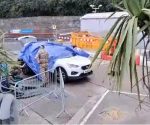Lessons From Nineteen Eighty Four: a prelude to a series on the deliberate wartime shelling of British civilians
The library chez Laurie is about to be further endowed with a copy of Secret Casualties of World War Two: Uncovering the Civilian Deaths from Friendly Fire, by Simon Webb, and there’s going to be a series at FBEL using the book as a launching point to explore the possibility that UK Government, through its military and in the name of trying to shoot down German and Italian aircraft, deliberately shelled British citizens during World War II.
A phenomenon that no one can dispute is that of the friendly fire death and destruction that was caused by anti-aircraft batteries when explosives fired into the air, and being mostly ineffective fell back to earth. Before we had all developed a post-9/11 perspective on the world, this death and destruction was shrugged off as being accidental, and not significant. However, now that there is sophisticated understanding of the false-flag attack as a tool of state craft, there is a need to understand if the anti-aircraft defences really did act as morale boosters for civilians – which is the excuse given for their deployment, and the disadvantages stemming from it, in the face of the fact that they didn’t stop the bombing – or if that policy in itself was a pretext for having heavy guns situated so that civilian casualties could be directly generated in order to motivate the population of Britain to tolerate and assist in the execution of a war.
Orwell’s Nineteen Eighty Four, which has been explained in the previous parts of this series as a work that actually describes London and Britain during World War II, and therefore the despotic and martial manner in which the country was governed, tantalisingly suggests that there was deliberate shelling of civilians. In the text of Nineteen Eighty Four, there is more than just the famous quote regarding Julia’s suspicions, which the reader is about to be reacquainted with, where one should understand that Orwell is telling an audience about false flag attacks on British people by UK Government blamed on the Germans. A very good example is reproduced here and tells of how escalated rocket bombing (shelling) coincided with a Party propaganda campaign to whip the proletariat into a pro-war frenzy. We are going to see in our investigation into the real life equivalent how shelling of citizenry would have been about motivating armaments production and maintaining a national war effort. With this understood, one can see how these moments of suggestion in the text were a device by which Orwell could get away with revealing a murderous secret – or, to record for posterity a zeitgeist of tacit understanding in a community of people who had a sense that the crime was being committed, but who wouldn’t have dared vocalise it because the powers that be were in fact as brutally totalitarian as anything that was ruling Germany.
So, first of all, here is the famous quote:
In some ways she [Julia] was far more acute than Winston, and far less susceptible to Party propaganda. Once when he happened in some connexion to mention the war against Eurasia, she startled him by saying casually that in her opinion the war was not happening. The rocket bombs which fell daily on London were probably fired by the Government of Oceania itself, ‘just to keep people frightened’.
The following more lengthy example stands up on its own as being suggestive of a false flag attack for moving a population on a crest of a emotional reaction: who could not recognise such a thing 20 years after the World Trade Centre was control demolished, during which there have been countless acts of “terror” to engender support for foreign military adventures and tolerance of domestic despotism? However, the reader is asked to consume the extract in conjunction with a viewing of a clip that has been prepared for the purpose from the 1936 film, Things to Come.
It is a film, and indeed book (full title: The Shape of Things to Come), that has been discussed before at FBEL in the articles Analysis Of “Things To Come”, Part One: Mystery Babylon Does All The War (here), and Analysis Of “Things To Come”; Part Two: From The Same Place As “Interstellar (here).
However, there’s nothing quite like looking directly at the form that served as material to propagandise the population of a country that did not know in 1936 what its overlords knew (because of course the overlords had planned what was about to happen). First of all, please read the extract from Nineteen Eighty Four, and then there will be a brief rundown of what to look out for in the film clip:
A new poster had suddenly appeared all over London. It had no caption, and represented simply the monstrous figure of a Eurasian soldier, three or four metres high, striding forward with expressionless Mongolian face and enormous boots, a submachine gun pointed from his hip. From whatever angle you looked at the poster, the muzzle of the gun, magnified by the foreshortening, seemed to be pointed straight at you. The thing had been plastered on every blank space on every wall, even outnumbering the portraits of Big Brother. The proles, normally apathetic about the war, were being lashed into one of their periodical frenzies of patriotism. As though to harmonize with the general mood, the rocket bombs had been killing larger numbers of people than usual. One fell on a crowded film theatre in Stepney, burying several hundred victims among the ruins. The whole population of the neighbourhood turned out for a long, trailing funeral which went on for hours and was in effect an indignation meeting. Another bomb fell on a piece of waste ground which was used as a playground and several dozen children were blown to pieces. There were further angry demonstrations, Goldstein was burned in effigy, hundreds of copies of the poster of the Eurasian soldier were torn down and added to the flames, and a number of shops were looted in the turmoil; then a rumour flew round that spies were directing the rocket bombs by means of wireless waves, and an old couple who were suspected of being of foreign extraction had their house set on fire and perished of suffocation.
The film clip starts with war being announced on the radio – the 1930s equivalent of rolling corporate-media – and palpably terrified civilians are shaken out of their feeling of freedom from fear and anxiety, complimented by the Christmas time context. Note that the losses to the fleet spoken of could be due to the firings of the battleship “Dinosaur”, which was firing ineffectually at a lone bomber plane – quite ironic, because the first anti-aircraft guns pointed at German air raiders were naval artillery mounted onto trucks. Mobile guns loosely of this type feature in the film clip, coming into a town centre – so right in amongst the civilian population [remember this detail for when we start to look at the real life version] – to blast shells into the air. This is after what the author would call a text book psychological warfare unit has terrorised the people with the alarm about “an air raid is coming to Everytown”. Everytown is at the same time the fictional name of the urban metropolis in which the story is taking place, but also every town. This is for the psychological manipulation of an entire country – and speaks of the intended extent of the deliberate shelling.
What we then see in the film is the anti-aircraft guns (which the civilians have been told are there to dispose of the enemy) firing while buildings collapse around them – and this is fascinating, because any fact of the involvement of aircraft is something that could be assumed (and in that case, buildings would be being felled by artillery incoming from another area). Indeed, the shrill voice over the tannoy speakers tells of how “the enemy are not in any great force”, and yet the destruction is huge. The only indication that there is an unseen perpetrator of the destruction is the droning noise that could be aircraft engines – although strictly empirically speaking, there would be no way of telling on the ground if this noise had anything to do with the catastrophe happening about one’s ears, or if it belonged to an enemy bombing run that was on its way to a military target. Crucially, what is presented to the viewer of the film is the dramatics of war experienced from a narrow perspective where, in fact, there’s only the slightest, and unverifiable indication of a direct link between enemy airplanes and the devastation being wrought on the ground. The conditioning message is this: when the anti-aircraft situated in your locality starts, it means that the enemy must be bombing your housing estates or suburb – but it clearly would not have been necessarily so.
What is incredibly interesting is how, just like in Orwell’s representation of an “air raid”, a film theatre is hit and made to collapse. Just as it features in Orwell, in the film, a child is shown lying in the rubble. It is as if both are referencing the same psychological warfare text book. And of course, the way they are precisely related is as follows: Orwell’s would no doubt be a retailing of a real war time event, despite its fictionalised disguise, and the incident shown in the film would be the idea to be realised. This suggests that the effect of “enemy bombing” on civilians (illustrated in Orwell) is something that would have been understood before the war – and also, the author dare says it, something sought. And from that perspective, it could be said that the 1936 film would have been an exercise in expectation management so that there could be acclimatisation to what was going to be (look out for the huge poster emblazoned with the words “WAR THE TRUTH”‡). It would constitute an effort to introduce a sense of fatalism so as to dampen anger at those actually responsible for the war (UK Government – as previously discussed†) and therefore ultimately enemy bombing (upon which all death and destruction will be blamed). Indeed, look at the way in which the population of Stepney resort to their conditioning and blame the non-existent hate figure of Goldstein (a supposed traitor), and then turn on some particularly vulnerable people – all instead of venting any indignation that had been brewing at the funeral procession towards its rightful target, the Oceanian/UK Government. We will no doubt see in our future investigation that the operation on the civilian population of Britain which needed the cover of enemy air raids was in part about shifting blame for the general hardship that was created while the country was made to undergo a purification (in the freemasonic alchemical sense) into a next phase of planned socialist evolution.
† See Analysis Of “Things To Come”, Part One: Mystery Babylon Does All The War (link above) – and
In Which We Observe H G Wells Agitating For A New World Order In 1940 (link) – and
Once, Collect Scrap Metal; Now, Wear A Mask: When Is UK Government Going To Pay For Its Crime? (link)
‡ Possibly also a tell (tale) as well as a kind of subliminal messaging.



















Does this explain the London Olympics opening ceremony in contemporary times perhaps?
Anti aircraft batteries on the rooftops and in the grounds of housing apartments!
There’s work being prepared at the moment that is related to the major security-apparatus-theatre psychological operation of July 2012.
Additional, 1/8/21: See The Freemasonic Olympics Takes Place Nine Years After 2012, But It’s No Moment Of Triumph For Toontown (The City Of London) – link